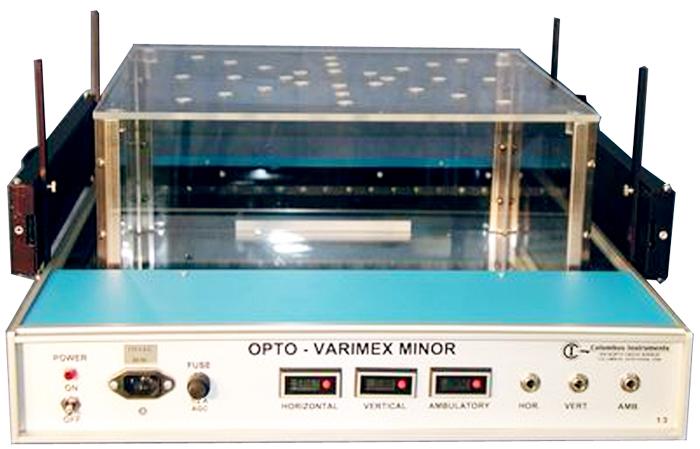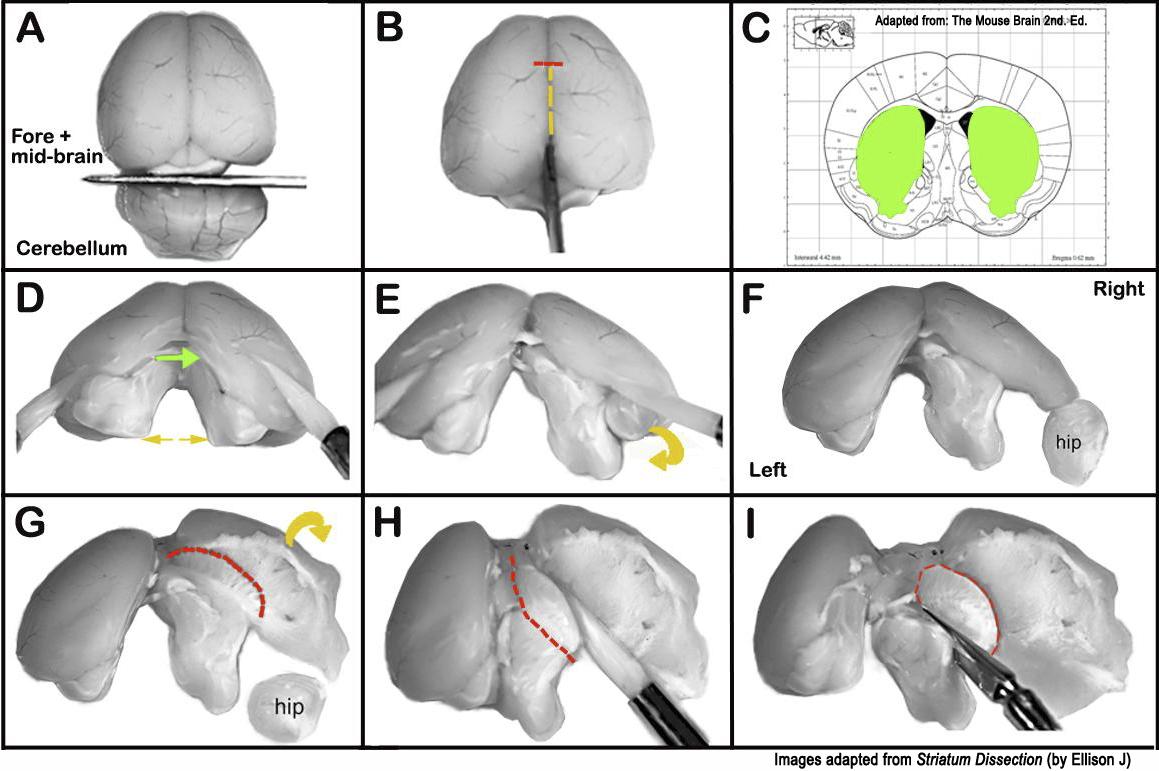Richfield1 project protocol
Behavioral, neurochemical, neuroanatomical, and neurotoxicological survey of the midbrain dopamine system in males of 15 inbred strains of mice (2003)
Richfield EK, Mhyre TR, Cory-Slechta DA, Thiruchelvam M, Chesler EJWith: Fry J, Lungu C
Project protocol — Contents
Workflow and sampling
Equipment
Reagents, supplies, and solutions
Procedure
Data
References
Workflow
Locomotor activity measurements Locomotor activity measurements Locomotor activity measurements Locomotor activity measurements Locomotor activity measurements Locomotor activity measurements Striatal dissection and tissue processing Striatal neurotransmitter measurements Automated locomotor activity chambers equipped with infrared photobeams (Opto - Varimax Minor; Columbus Instruments International Corp., Columbus, OH)
- Dissecting instruments for small rodents: iris scissors, gauze scissors, scalpel (#10), 2 stiff brushes, forceps
- Stereomicroscope: for micro-dissection of the striatum
- Sonicator: for tissue disruption
- Centrifuge
Equipment for HPLC electrochemical (HPLC-EC) analysis
• Column heater
• Waters 717 Plus Autosampler
• Waters Model 510 pump (Waters, Milford MA, USA)Alltech® Alltima™ HP C18 Analytical HPLC Column (Alltech, Deerfield, IL, USA)
• Particle size: 5 µm
• Dimensions: 250 x 4.6 mm
• Mobile phase: 0.1 M disodium phosphate, 0.1 M citrate, 0.15 mM EDTA, 1.4 mM octyl sodium sulfate, 12% methanol
• Flowrate: 1 mL/min
• Temperature: 35°CElectrochemical Detection
• LC amperometric potential = 0.75 V (referenced to Ag/AgCl electrode)
• detector sensitivity = 2 nA
- Roccal-D (VWR, Inc., West Chester, PA), for cleaning and disinfecting boxes
- Bucket of ice and dry ice
- -80°C freezer
- Bio-Rad protein assay (Hercules, CA)
- 4% Paraformaldehyde: for postfixation
- 0.1 N Perchloric acid
- 0.5 N Sodium hydroxide (NaOH)
- 0.1 M Disodium phosphate (NaH2PO4)
- 0.1 M Citrate
- 0.15 M Ethylenediaminetetraacetic acid (EDTA)
- 1.4 mM Octyl sodium sulfate
- 12% Methanol
- All chemicals and solvents were of analytical grade or better and were purchased from Sigma (St. Louis, MO)
Acclimation to test conditions
In general all male mice are acclimated in the University of Rochester Medical Center vivarium for approximately one week.
I. Measurement of locomotor behavior
a. Male mice acclimated for at least a week in the vivarium facility are randomly assigned into 2 testing groups.
b. Within each testing group, mice are brought in their cages from the vivarium and individually and randomly assigned an automated locomotor activity chamber and tested the same time everyday for 3 consecutive days.
c. Daily sessions are 45 min under fluorescent lighting with a mean of 328.1 +/- 17.6 lux in the center of the chamber and recorded at 3-min intervals.
d. Measurement of locomotor activities are readily obtained in terms of beam breaks by virtue of the chambers being equipped with two sets of infrared photobeams (3 mm diameter): (1) interspersed at 24.4 mm along the horizontal plane and 39 mm rise or elevated from the chamber floor, and (2) divided the chamber vertically and are located 57 mm above the horizontal photobeams.
e. Daily testing is accomplished from 0900 h (9 am) to 1700 h (5 pm) and mice are assessed for short-term (1 day) habituation and long-term habituation (3 days).
f. Each daily/session of locomotor activity counts are totaled and recorded into 3-min intervals/blocks.
g. To check for unforeseen effects of the random grouping and to compare the two groups, C57BL/6J is run in both groups (n=10 mice per group).
II. Brain striata preparation
a. Following behavioral testing, mice are sacrificed in a random order by cervical dislocation.
b. Brains are quickly harvested and placed on ice.
c. The right and left striata are dissected (see Figures 1 A-I below), quickly frozen on dry ice, and then stored at -80°C freezer until analysis.
Figure 1 A-I: Schematic dissection of the striatum for the determination of striatal neurotransmitters. Fig. 1-A: Dorso-ventral view of the harvested brain and the transection of the cerebellum. Fig. 1-B: The forebrain is transversely resected at midline beginning at the red line. Fig. 1-C: Schematic cross-section of the brain showing the left and right regions of the striatum (green). Fig. 1-D: Using 2 stiff brushes, the partially halved brain in Fig. 1B is gently spread apart (yellow arrows). Fig. 1-E: While the left brush is used to stabilize the brain, the right brush is carefully placed into the hippocampal groove (green arrow in Fig. 1D) and gently rotated until the hippocampus is displaced. Fig. 1-F: The hippocampus (hip) is shown displaced from its groove. Fig. 1-G: Using the brush to further undermine the brain, the right hippocampus is completely severed from the right cortex and in turn the cortex is flipped medial-laterally to expose the medial surface of the right striatum (demarcated by red lines). Fig. 1-H: Using the same brush, the lateral limit of the right striatum is bluntly dissected along its perimeter in order to move it medially for harvesting. Fig. 1-I: The right striatum is transected along the dashed red lines (Fig. 1H and I) using an iris scissor. Steps Figs. 1E-I are repeated for the left half of the brain to harvest the left striatum.
III. Neurotransmitter analysis
a. The left striatal samples are placed in 1 mL 0.1 N perchloric acid, sonicated, and centrifuged at 1000 x g at 4°C for 8 min, as described (Thiruchelvam et al., 2000a; Thiruchelvam et al., 2000b).
b. Supernatants are then stored at -80°C freezer until HPLC-EC analysis.
c. Tissue pellets are digested in 1 mL of 0.5 N NaOH, and total protein content is determined using Bio-Rad Protein Assay.
d. For HPLC-EC analysis, samples are loaded automatically, run on a heated column (35°C) with the mobile phase delivered at a constant speed of 1mL/min.
e. The liquid chromatography (LC) amperometric potential is set at 0.75 V and the Ag/AgCl electrode is used as a reference.
f. Signals from the LC detector are recorded, and data are analyzed using Waters Millennium 2010 Chromatography Manager.
Data collected by investigator
Daily activity of 45-min session are recorded as 3-min blocks or intervals.
Horizontal, ambulatory, and vertical activities: total counts for each session (over days 1, 2, 3).
The following neurotransmitter concentration were collected and are expressed in ng per mg total protein:
• dopamine (DA)
• serotonin (5HT)
• dihydroxyphenylacetic acid (DOPAC)
• homovanillic acid (HVA)Definitions and Calculations
horizontal locomotion = single beam break in the horizontal plane
vertical locomotion = single beam break in the vertical plane
ambulatory locomotion = two consecutive beam breaks in the horizontal plane
DA = dopamine
DOPAC = 3,4-dihydroxyphenylacetic acid
HVA = homovanillic acid = 4-hydroxy-3-methoxyphenylacetic acid
5HT = serotonin = 5-hydroxytryptamine
habituation: change in counts over a defined period of time (slope). Slopes are calculated by linear regression.
short-term habituation: change in activity counts over 45 min on day 3 [n/min]
long-term habituation: change in activity counts over days 1-3 [n/day]
Dopamine turnover was expressed using two methods:
DA_turnover1 = [DOPAC ÷ DA] x 100
DA_turnover2 = [(DOPAC + HVA) ÷ DA] x 100
References
Prasad K, Winnik B, Thiruchelvam MJ, Buckley B, Mirochnitchenko O, Richfield EK. Prolonged toxicokinetics and toxicodynamics of paraquat in mouse brain. Environ Health Perspect. 2007 Oct;115(10):1448-53.
PubMed 17938734 FullText

